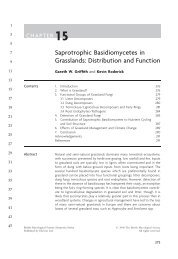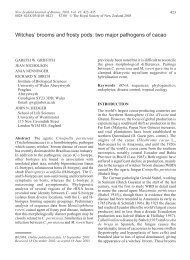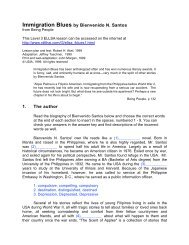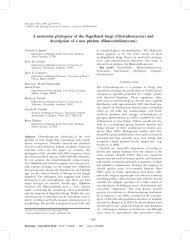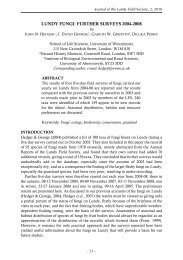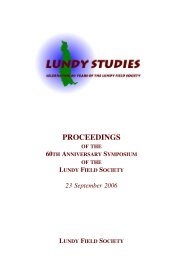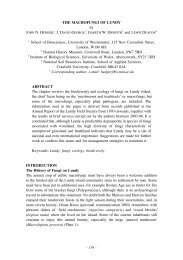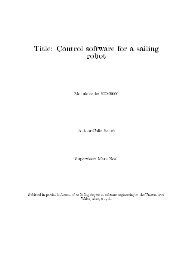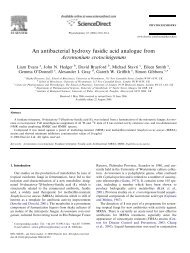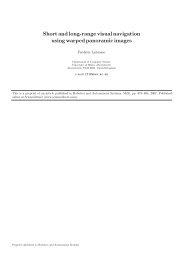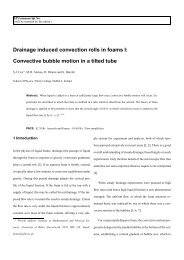Anaerobic rumen fungi
Anaerobic rumen fungi
Anaerobic rumen fungi
You also want an ePaper? Increase the reach of your titles
YUMPU automatically turns print PDFs into web optimized ePapers that Google loves.
ANAEROBIC RUMEN FUNGI<br />
in the area available for infection. Rumen <strong>fungi</strong> also show protease activity that may have role in<br />
degradation, because the plant structural proteins increase the integrity of plant cell wall (Wallace<br />
and Joblin, 1985). Species of Piromyces, Neocallimastix, Orpinomyces and Anaeromyces degrade fibre<br />
to a substantial degree. Caecomyces species degrade fibres but lesser than other genera (Gordon,<br />
1990), perhaps because of the lack of an extensive rhizoidal system. In Bermuda grass (Cynodon<br />
dactylon), stems and leaves harbour Neocallimastix and Orpinomyces species to degrade the plant<br />
material most effectively by weakening the textural strength of the residue (Akin et al. 1990).<br />
These findings suggest that the ability to degrade fibre varies among fungal genera, and that<br />
plants differ in their support for fungal growth. The greater ability of <strong>rumen</strong> <strong>fungi</strong>, compared to<br />
<strong>rumen</strong> bacteria, to weaken forage fibres may be vital to enhancing its utilization by the host<br />
animal (Borneman and Akin, 1990).<br />
Ito et al. (1994) studied sheep <strong>rumen</strong> <strong>fungi</strong> for degradability and digestibility of rice straw<br />
and observed significant decrease in lignin residue that in turn increased digestibility of the feed.<br />
Studies by Manikumar et al. (2002) and Dey et al. (2004) indicated increased in vitro dry matter<br />
digestibility, and decreased cell wall contents of straws by different anaerobic <strong>fungi</strong> viz,<br />
Orpinomyces, Piromyces and Anaeromyces relative to untreated controls. Also, the molar yield of<br />
acetate increased with simultaneous decrease for propionate and butyrate. In a subsequent<br />
report, hydrolysis of rice and wheat straw by Orpinomyces sp. (C14) was superior to that of<br />
Piromyces or Anaeromyces (Manikumar et al. 2003).<br />
Gordon and Phillips (1998) reported a 7-12% increase in voluntary intake of straw based diet<br />
by sheep dosed with monocentric <strong>fungi</strong> from other herbivores. In contrast, no such effect on feed<br />
intake was observed in crossbred calves dosed with polycentric Orpinomyces sp. However, the<br />
growth rate and nutrient digestion in cow calves improved in the fungus-administered sets.<br />
There was also a two and a half fold increase in the fungal count in <strong>rumen</strong> liquor of fungusadministered<br />
animals (Dey et al. 2004).<br />
Lee et al. (2000, 2004) studied the effect of administration of Orpinomyces strain KNGF2 from<br />
Korean native goats, or their enzymes on the extent of ruminal fermentation, microbial<br />
population, enzyme activities and nutrient digestion in sheep <strong>rumen</strong>. There was a 2-3 fold<br />
increase in cellulolytic bacterial count in case of anaerobic fungal treatment of silage based ratios<br />
compared to the control.<br />
9. FIBROLYTIC ENZYMES<br />
The ability of ruminants in digesting the plant structural polysaccharides, primarily cellulose<br />
and hemicelluloses, depends on the capacity of microorganisms inhabiting <strong>rumen</strong>, and <strong>rumen</strong><br />
<strong>fungi</strong> play a major role in degradation of lignified plant tissues (Akin and Benner, 1988). For plant<br />
cell wall degradation, such anaerobic <strong>fungi</strong> produce a wide range of hydrolytic enzymes,<br />
cellulases (Barichievich and Calza, 1990; Yanke et al. 1993), hemicellulases (Mountfort and Asher,<br />
1989), proteases (Michel et al. 1993), amylases, amyloglycosidases (Paul et al. 2004), feruloyl and<br />
p-coumaryl esterases (Borneman et al. 1992), various disaccharidases (Chen et al. 1994),<br />
pectinases (Gordon and Phillips, 1992) and exonucleases (Cabe, 1998).<br />
Three enzymes viz, endo-1,4--glucanase, exo-1,4--glucanase and -glucosidase act<br />
synergistically for efficient cellulose hydrolysis. These enzymes often bind to the substrate prior<br />
to hydrolysis, but they may also bind to other plant cell wall polymers such as xylan (Gilkes et al.<br />
1991). Aryl esterases, viz. p-coumaroyl esterases and feruloyl esterases are other important<br />
enzymes that hydrolyze the ester linkages between hemicellulose and lignin in plant cell walls,<br />
381



